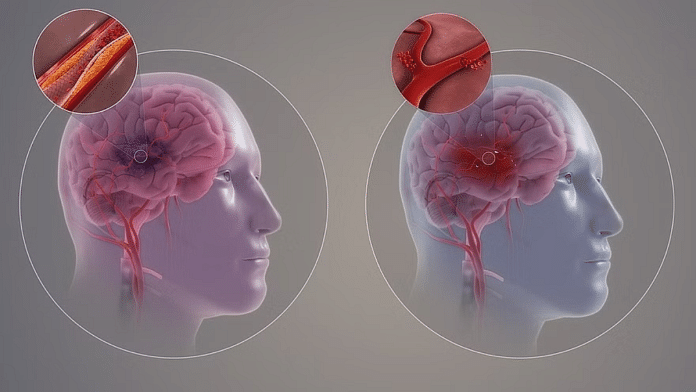New Delhi: India recorded nearly 13 lakh new stroke cases in 2019 — the highest in the World Health Organization’s (WHO) South-East Asia Region (SEAR) — a new study has found.
Including those already suffering from it, nearly 1 crore people were affected by strokes in India that year according to the study, part of a series of four published Tuesday in The Lancet. It was carried out by researchers associated with the Indian Council of Medical Research (ICMR) and other medical institutions in India, Sri Lanka and Singapore.
A stroke, also known as a brain attack, occurs when something blocks the blood supply to part of the brain (ischemic stroke) or when a blood vessel in the brain bursts (haemorrhagic stroke). In either situation, parts of the brain become damaged or die. It can result in lasting brain damage, long-term disability, or death.
The first study, titled ‘The burden, risk factors and unique etiologies of stroke in South-East Asia Region (SEAR)’, was carried out by researchers affiliated with Christian Medical College and Hospital, in Punjab’s Ludhiana, Delhi’s All India Institute of Medical Sciences (AIIMS) and St. Stephen’s Hospital, the Christian Medical College in Vellore, and ICMR’s National Centre for Disease Informatics and Research.
Researchers from Sri Lanka’s University of Kelaniya and Singapore’s Raffles Hospital were also involved in the study.
Low- and middle-income countries (LMIC) are particularly susceptible to stroke deaths, the studies have found. In a second article titled ‘Pragmatic solutions to reduce the global burden of stroke: a World Stroke Organization–Lancet Neurology Commission’, researchers project a surge in stroke deaths worldwide to 9.7 million by 2050 from 6.6 million in 2020, with LMIC countries being especially affected by it.
“Stroke is the second leading cause of death worldwide and the burden of disability after a stroke is also large, and is increasing at a faster pace in LMIC countries than in high-income countries. Alarmingly, the incidence of stroke is increasing in young and middle-aged people, aged less than 55 years, globally,” according to the second study.
The studies propose “pragmatic solutions for the implementation of evidence-based interventions to reduce the global burden of stroke”.
ICMR Director General Dr Rajiv Bahl, who also released the study separately, stressed the importance of implementing evidence-based stroke care to mitigate disability and prevent new strokes.
“ICMR is actively engaged in crafting country-specific ambulatory care models at the primary care level to combat non-communicable diseases,” he said in a statement.
Also Read: At 3.02 million, India recorded world’s highest number of preterm births in 2020, finds Lancet study
Increase of stroke deaths in low- and middle-income countries
According to the second Lancet study, by 2050, “it is estimated that the contribution of stroke deaths in low- and middle-income countries (LMIC) will see an increase from 86 percent to 91 percent”.
The absolute number of people affected by stroke — which includes those who die or suffer from disabilities as a result — has almost doubled in the past 30 years, the study adds.
Researchers say the leading causes of stroke in India include hypertension, diabetes, dyslipidemia (high cholesterol) and tobacco use, but also dengue, tuberculosis, and snakebites.
According to the first Lancet study, the Global Burden of Disease data for 2019 showed that in the case of stroke, the overall incidence (crude numbers) was 1,328,397, with a prevalence of 10,423,817 per year in the South-East Asia Region.
A crude rate is the number of new cases (or deaths) occurring in a specified population in a given year. This is usually expressed as the number of cases per 100,000 population at risk.
According to the study, the highest incidence and prevalence of strokes are reported in India (1,291,245 and 9,650,716). This is followed by Indonesia (642,943 and 4,918,487) and Bangladesh (182,856 and 1,417,979).
Dr Praveen Gupta, principal director and head of the department of neurology of Gurugram’s Fortis Memorial Research Institute, said that increasing pollution and “lifestyle factors” were responsible for the growing number of stroke cases in India. Dr Gupta was not associated with the study.
“Also, we are increasingly seeing a large number of patients under 40 years of age, without any known risk factors, reporting stroke in Indian hospitals,” he told ThePrint.
(Edited by Uttara Ramaswamy)



